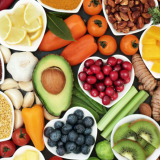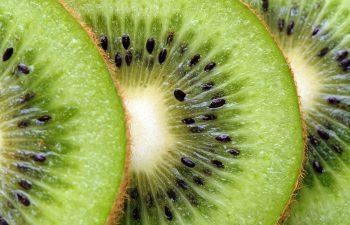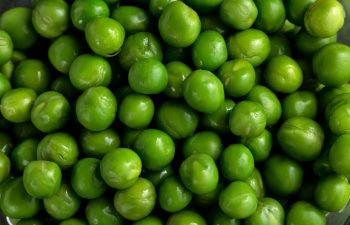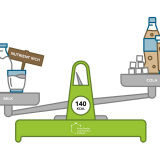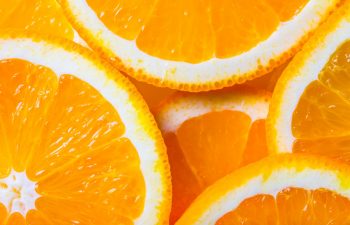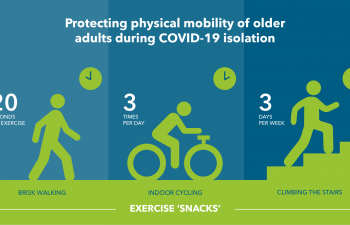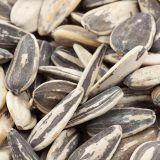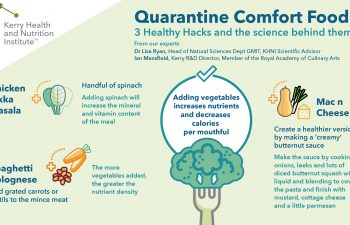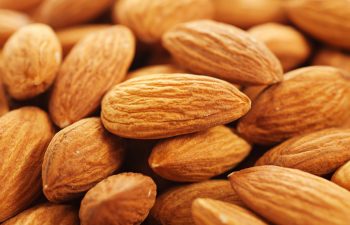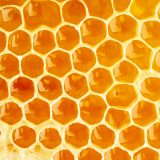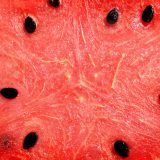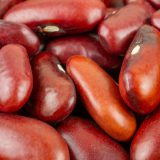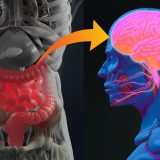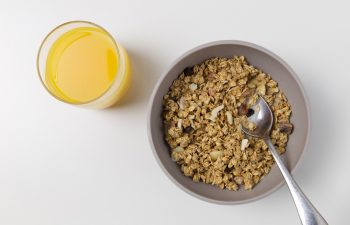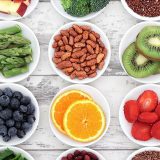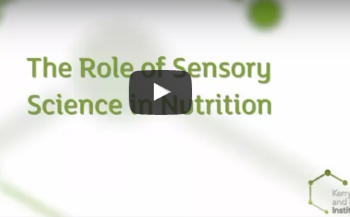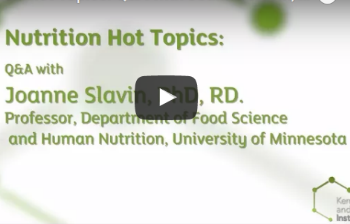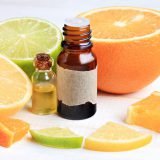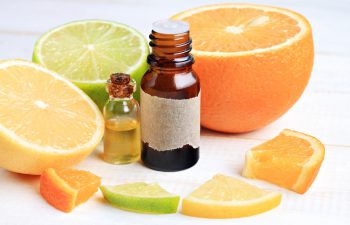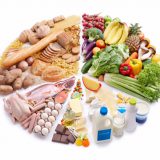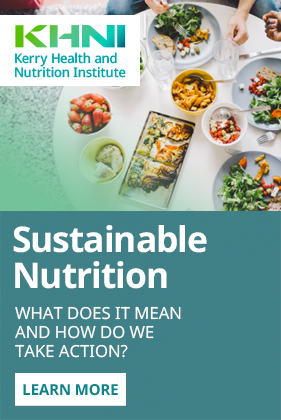Earth Day, celebrated every April 22, is a time to reflect on our planet’s health and consider how our everyday choices impact the environment. It is important to recognize the relationship between Earth Day and nutrition/sustainability. Highlighting why these concepts are essential in the fight against climate change and environmental degradation. Understanding Sustainable Nutrition Sustainable… Read more »
Blog
- All
- Plant-based
- Protein/Exercise/Physical Activity
- Sustainability and Food Production
- Sodium
- Sugar and Calorie Reduction
- Immune Health
- Digestive Health
- Energy/Cognition/Mood/Brain
- Taste and Sensory Science
- Diet Trends and Healthy Behaviour
- Food Science and Technology
- Food Safety and Waste Prevention
- Life Stage Nutrition
Have you ever heard of the phrase “carrots can help you to see in the dark”? This long-standing belief originating from the second world war has been passed around millions of households throughout generations. (1) This begs the question – can the food we consume improve our eye health and visual perception? Not only is… Read more »
Ready to eat (RTE) meat products have short shelf lives unless special precautions are taken to maintain and extend their shelf life. They are subject to spoilage by various bacteria that cause organoleptic and eating quality changes that make them unacceptable to consumers. They are also subject to some pathogenic bacteria that can cause food… Read more »
Almost 100 years ago when childhood mortality due to infectious disease was high, Dr. Carl Naslund noticed a curious thing – Swedish children that had received a tuberculosis vaccine not only were protected from tuberculosis but were three times less likely to succumb to any disease compared to the children who weren’t vaccinated. Decades later,… Read more »
Do you know your pro-biotics, pre-biotics, botanicals and supplements, from your vitamins, macro-nutrients and micro-nutrients? All can help women manage their physical and emotional wellbeing, but what should you consider taking and when? “Nutrition plays a role in women’s health, both in managing different life stages and in promoting long-term health, but with so many options… Read more »
Salt intake is significantly higher than the daily recommendation in many countries. What is being done globally to reduce salt intake, and how effective have these strategies been?
The future of food production relies on significant advances in microbiology, bioprocessing, enzyme technology and artificial intelligence, in order to feed a growing population, set to reach almost 10 billion people by 2050, while also reducing the negative impacts of food production on the planet. Recent advances in synthetic biotechnological processes such as precision fermentation… Read more »
In recent years, the importance of ensuring that the food we eat is sustainably sourced and nutritionally complete has been to the forefront for consumers and policy makers alike. Many governments globally have begun to incorporate sustainability into their country’s food based dietary guidelines (FBDGs). They wish to ensure that the food that they recommend… Read more »
Dr. Lisa Ryan, Head of Department of Sport, Exercise and Nutrition at Atlantic Technological University and Scientific Advisory Council member of KHNI discusses the benefits of reducing alcohol on health and mindfulness with Derek Brown, a renowned author, wellness coach, bartender and Founder of Positive Damage. Discover key insights into the benefits of reducing alcohol,… Read more »
Innovation in research and technology make 2024 an exciting time for nutrition and health in food and beverage. Our sixth annual edition of the KHNI Health & Nutrition trends explores the developments in research, technology, product development and the consumer landscape which are propelling the food and beverage industry, as well as global food system,… Read more »
In 2023, our experts focused on a few of the major factors influencing the world of food, beverage, and nutrition – Sustainable nutrition, Women’s Health, the microbiome, food waste, and nutrients linked to health such as sodium reduction. As we look back on 2023, we wanted to share the top health and nutrition pieces that… Read more »
Earlier this year, Dr. Lisa Ryan, spoke at KHNI’s 2023 Health and Nutrition Trends webinar, highlighting the pivotal role of cognitive health in tying together various wellness trends. Emphasizing that mental well-being is the foundation for achieving desired activity levels and daily routines, Dr. Ryan stressed the impact of the pandemic on prompting reflection about… Read more »
With women’s health being an important focus for health and nutrition, one area of women’s health is that is sometimes overlooked is the menstrual cycle. Over the course of the menstrual cycle, those who menstruate have different calorie and nutrient requirements due to fluctuations in hormones. These hormones not only influence your monthly cycle, but… Read more »
The intestinal microbiome, a diverse community of microbes that coexist within our bodies, may hold the key to enhancing our athletic performance. Research has shown that athletes have a distinct gut microbiota profile compared to sedentary people. How does athletic performance affect the intestinal microbiota and how can it benefit those who are less active?… Read more »
Sustainable Nutrition is defined as the ability of food systems to provide sufficient energy and essential nutrients to maintain good health of the population without compromising the ability of future generations to meet their nutritional needs (A Path from Sustainable Nutrition to Nutritional Sustainability of Complex Food Systems). It is nutrition that is produced and delivered… Read more »
The Elderberry Market In the wake of the COVID-19 pandemic, ‘natural’ proactive and immune health solutions have been highlighted as a growing area of consumer interest, with over half of global consumers outlining a willingness to use supplements if they had a greater understanding about the ingredients those supplements contain (1). As consumers continue to… Read more »
According to recent research conducted by the KHNI, Women’s Health has emerged as one of the top 10 major health and nutrition trends in 2023. This highlights the importance of addressing the unique health and nutritional needs of women at various stages of life. In KHNI’s recent webinar “Innovating for Women’s Health”, Izaskun Monsalve and Monica… Read more »
With the population expected to reach 9.8 billion by 2050, there has been much debate about how to feed this global population without overstepping the planetary boundaries and accelerating global warming. It is well understood that drastic change is needed to our current food systems and transitioning human consumption patterns [1] have been identified as a… Read more »
The European legislation for Emulsifier E 471 (mono- and diglycerides of fatty acids) will be amended by the European Commission after recommendations by the European Food Safety Authorisation (EFSA). The updated specification for E 471 will be extended with additional contaminants commonly found in emulsifiers, i.e., Glycidyl Esters (GE) and 3-monochloropropanediol (3-MCPD). Mono- and diglycerides… Read more »
Enzymes are used in food processing as a natural way to improve nutrition and texture. Learn about their importance in plant-based foods, infant formula, and more.
With the global population predicted to grow to 9.7 billion by 2050, there is increased focus on sustainable food production to meet rising demand worldwide. One major consideration is how food production contributes to food waste and how food waste impacts the world. In this article, we take a holistic and collaborative approach to understanding… Read more »
The importance of hydration lies in its role in allowing the body to perform our internal processes effectively and efficiently. Learn more about hydration’s impact on physical health and mental health.
In 2022, our experts focused on a few of the major factors influencing the world of food, beverage, and nutrition – the microbiome, food waste, and nutrients linked to health like fibre and omega-3 fats. These nutrition articles were the most popular among our readers from our content published last year.
Fresh berries are rich in nutrition but can spoil quickly and generate more food waste. What is the best way to preserve the nutrition of berries when processing to improve portability, shelf life, or usability into foods and beverages? Frozen? Dried? Juice?
Kokumi has been part of the Japanese culinary tradition for centuries. It is associated with foods that exhibit a fullness, succulence and craveability. Is it a taste? How does it work to improve flavor of food?
A postbiotic is defined as a “preparation of inanimate microorganisms and/or their components that confers a health benefit on the host”. Emerging science on postbiotics is showing a role in digestive health and even mood for humans, as well as the potential to improve the safety and efficiency of our food supply by improving animal health.
A Life Cycle Assessment (LCA) is a science-based quantification of all of the environmental impacts created over the entire life cycle of a product. It is a tool being used more commonly in the food and beverage industry as companies try to evaluate and reduce the impact their businesses have on the planet and a stepping stone toward a future of sustainable nutrition.
Wendy Sweet, PhD, founder of My Menopause Transformation, explores the science of how nutrition can support management of menopause symptoms.
How are enzymes used to make food more sustainable? Learn about the importance of enzymes in reducing the environmental impact of food production of food categories like bakery, meat, fish, and brewing.
What is cultivated meat and how is it made? What is the environmental impact of replacing conventionally grown meat with cultivated meat, and will it be one of the greatest human achievements to date? Kyle Probst, PhD, explores the science to find answers to these questions.
There is more to protein than just the amount we eat when it comes to maximizing performance and muscle health.
Nutrition and immunity can be a difficult space to navigate. Vitamin C, zinc, probiotics, beta glucans, and selenium are among the most common nutrients or ingredients used for supporting immune health. Supporting immunity with functional ingredients is top-of-mind for many people around the world, but how do you know which ingredients and nutrients are actually… Read more »
Choosing fibre sources can be difficult because different fibres have different health benefits as well as different functional properties in food. This article provides an overview of Acacia fibre, including its origin, high digestive tolerance, and examples of how it can help formulation of different foods and beverages.
It has been more than 15 years since the EU published legislation limiting the types of claims that can be made on ‘unhealthy’ foods, but there is still not agreement on the exact nutrient profiles to be used. What challenges have led to this long journey, when can we expect unified guidelines on nutrient criteria for claims and front-of-labelling, and how will it impact the food and beverage market?
Does intermittent fasting lead to weight loss and how does it compare to other weight loss methods? We look at science to find the answer.
Our science-based resources on immunity, plant-based eating, and mental wellness were among our most-read nutrition articles in 2021.
Learn how dietary fiber can improve the texture, functionality, and nutrition of plant-based meat alternative and meat products.
Upcoming EU regulations will change which types of natural flavouring sources are acceptable in organic products. Nicolas Barthes, BSc walks through the legislation, how extracts are made, and how to decide which type of extracts are appropriate for different foods and beverages.
Learn about the purpose of lecithin and other emulsifiers in food, which foods typically contain them, and more.
Low-calorie beverages can be an important part of addressing high sugar and calorie intake, but many products do not succeed because key sensory factors are not addressed beyond sweetness. Tools from sensory and analytical sciences can be key to building back mouthfeel in beverages which have reduced levels of sugar.
Energy can mean physical energy from calories, stimulation from caffeine, or mental focus from ingredients like adaptogens. Finding the best solution means knowing which benefit different consumers are looking for during each time of day.
Upcoming legislation will restrict advertising and price promotions of unhealthy foods in the UK. We share formulation tips to improve nutrition scores based on the criteria used in the legislation.
The food currently lost or wasted globally is enough to feed 2 billion people. This article uses bread and bakery as a case study to review how individuals and food producers can take action against food waste.
Concussions, often called the ‘invisible injury’, do not just affect athletes and result in changes to the metabolism of the brain and body. Learn about the latest research and recommendations for nutrition’s role in recovering from brain injury from Dr. Lisa Ryan, a global leader in this area of research.
Which nutrients can support focus, memory, or help prevent cognitive decline during ageing? KHNI Scientific Advisor Lisa Ryan, PhD, RNutr summarizes the state of the science and what the future might bring.
Plant-based meat alternatives have different nutrient profiles, go through different processing conditions, and contain different ingredients than meat. As a result, they have different challenges when it comes to food safety and shelf life.
Plant-based meat alternatives often have challenges with off-tastes like bitter, earthy, beany, astringent, and green. Understanding the chemistry and source of off-notes can help mask them efficiently without negatively impacting the nutrition.
Over 170 million tonnes of sugar are consumed annually, resulting in increased risk of obesity and chronic disease for many as well as production of substantial CO2 emissions, land, and water use. Sugar alternatives that can improve both health and sustainability outcomes can be an important tool for the future health of the planet.
Many people are familiar with probiotics and the health benefits they can have, like digestive health and immunity, but how do they actually work in the body to cause a health benefit? Some interact with other microorganisms in our microbiome, while others interact directly with the body’s organs.
Plant proteins are seen as key to the future of the planet, but they may have some limitations for active ageing. This article reviews actionable strategies such as processing, protein blending, or targeting leucine content that can improve the ability of plant proteins to promote active ageing.
How can the foods we eat influence our mood? Has science been able to explain a link between food and mood? In this KHNI Q Science Short, Aoife Marie Murphy, PhD answers these questions and more. KHNI Q is a video series where scientific experts demystify the science behind healthier food.
Muscle is key to staying active at 50+, but ageing reduces our ability to activate muscle growth and repair, leading to a potential loss of up to 50% of our muscle mass between the ages of 30 and 80. Learn the science of why this happens, and how more protein can promote active ageing.
Reformulating foods to reduce content of nutrients like sodium, sugar, and fat is a key pillar of public health strategies globally. Learn about new research that explores the impact of reformulation on nutrient intakes and consumer acceptance.
2020 brought a lot of surprises for the areas of food, health, and nutrition. It changed the topics people wanted to learn about, foods people shopped for, prepared, and ate, and how each of us chose to cope with stress. Most importantly, it had many of us searching for science-based answers to many of our… Read more »
Plant-based foods are no longer getting a free pass on nutrition and emerging studies show that we must take care to include beneficial nutrients beyond protein. Avoid common nutrition pitfalls when formulating plant-based foods with tips on nutrient content, protein quality, and more.
The Ketogenic diet is a low carbohydrate, high fat (LCHF) diet Different dietary trends come into popularity at various stages and recent times have seen the resurgence of the low carbohydrate – high fat diet (LCHF) diet, this time in the form of ‘the ketogenic diet’. This diet encourages less than 10% of total calories… Read more »
Is dairy fat healthy or unhealthy? Why do we see recommendations to reduce saturated fat intake, while at the same time see headlines from studies showing full-fat dairy may be healthy for us? The answer lies in the fact that food can often be more than the sum of its parts. Dairy, saturated fat &… Read more »
Soy has received more attention in the past few years due to the growing popularity of plant protein and plant-based diets. However, there have also been mixed messages about soy in the media over the past few decades, which leaves many people confused about soy’s role in health. “Is soy unhealthy or healthy?” is the… Read more »
Plant sources of protein offer many benefits for health and the environment. These benefits are aligning with consumer values and creating a demand for more plant proteins in food.
In our recent article, we described the “Quality Calorie concept” from the British Nutrition Foundation, which is an approach to looking beyond total calories to improve total nutrient density of the diet. Many of the approaches described in the Quality Calorie concept can be adapted by the food and beverage industry to make a substantial… Read more »
Anyone who has ever been on a diet will be familiar with the terms ‘reduced calories’ or ‘counting calories’, but what about the other parts of a healthy diet, beyond calories? Nutrient density has a large role to play in a healthy diet. The high obesity rates globally suggest that on average, we consume too… Read more »
Staying at home with minimal human contact can significantly increase our feelings of loneliness. People of all ages may experience loneliness. However, older people, particularly those living alone and advised to “cocoon”, are especially vulnerable. Loneliness and social isolation can negatively impact our mental and physical health (1), in part through adversely affecting behaviours like… Read more »
What does Vitamin C do for the immune system? Vitamin C is one of the most common nutrients that comes to mind when thinking about immunity. It is a water-soluble vitamin that serves as a cellular antioxidant, which means it protect cells from reactive oxygen species and cellular damage. This includes protecting immune cells from… Read more »
Beta glucans are ingredients that are becoming more and more common to see in functional foods and beverages positioned for immune health. While many people might be aware of the role of oat beta glucans for heart health, beta glucans are not just for heart health. For example, there are numerous clinical studies showing the… Read more »
Probiotics are not just for digestive health. The gastrointestinal tract is where our body is able to determine which parts of the foods we eat should be allowed passage into our body, and which should not be allowed entry. We want to absorb nutrients from the food we eat, but we do not want to… Read more »
People aged 60 years and over are a vulnerable group with respect to the recent COVID-19 pandemic. Measures to protect older people from contracting the virus include personal hygiene practices, social distancing and staying at home. These are extraordinary measures, and while it is vital for public health that these are adhered to, they can… Read more »
What does selenium do for the immune system? Selenium is important in the immune system’s ability to protect against infection. Selenium is a mineral that is important for a group of proteins called selenoproteins, which have quite a few different functions in the body. Some selenoproteins, called glutathione peroxidases, are important for the body’s antioxidant system,… Read more »
Circumstances surrounding COVID-19 mean many people are at home more than usual. One way to stay connected to family, food, and mental health is to cook some of your favorite dishes. However, when we’re less physically active during isolation, the extra calories that come with comfort foods may not be so comforting. Here are some… Read more »
Comfort and stress eating are on the rise during the COVID-19 outbreak with many of us now spending much of our time at home. However, food also plays a key role in helping us stay well and healthy during isolation. We sat down with a panel of experts to bring you their perspectives on nutrition,… Read more »
The immune system is complex, and different nutrients can have different roles in supporting immunity. Zinc is one of the more common nutrients brought up in the immunity conversation, so let’s take a look at what it does. What does zinc do for the immune system? Zinc helps the body’s different defense cells develop and… Read more »
What is the difference between sugar and added sugar? For those in the food and nutrition world, added sugar might be something we hear about every day. Global dietary recommendations continue to recommend reducing added sugar intake, legislation taxing added sugar content of foods or beverages is increasingly common, and the update to the nutrition… Read more »
Key takeaways: Dietary recommendations change because science develops new understanding It is key to focus on an entire food’s role in health, not just one nutrient or chemical within that food One of the most common criticisms of nutrition science is how confusing it can be. Recommendations will change from “eggs are unhealthy, avoid them”… Read more »
Animal nutrition has a direct impact on human health ‘You are what you eat’. This phrase is used to encourage us think hard about our food choices, but what does it really mean? And when we think about what we eat, what is the impact of the nutrition that is provided to the animals that… Read more »
Hosted in Dublin, October 15th to 18th, the 13th Federation of European Nutrition Societies (FENS) Conference is the premier European meeting in its field. The theme for this year’s conference was “Malnutrition in an Obese World – European Perspectives”, and featured a wide range of international speakers, covering the spectrum of nutritional science in plenary… Read more »
Dining out of home and calorie-rich restaurant menus are often blamed as a main driver of the obesity issue worldwide. World Health Organization global estimates that more than 1.9 billion adults aged 18 years and older are overweight (WHO,2018). What if we could make healthier choices in restaurants more obvious and easier to make for… Read more »
Key takeaways from Pangborn 2019: Eating experience and environment has a large impact on food preference. Researchers and those seeking to maximize food preference need to consider consumer experience, using immersive techniques (e.g. augmented reality) to collect more realistic data. Sensory cues can be used to design products that can help make the healthy choice… Read more »
Conscious consumers want to feel that a food or beverage aligns with their beliefs, which has led to a push for claims like ‘free from artificial colors or preservatives’, ‘organic’, and ‘made with natural ingredients’. Consumers who seek foods that they perceive as natural and healthy don’t offer the industry a consistent definition of what… Read more »
Dairy products from grass-fed cows are in growing demand among today’s consumers, driven mostly by perceived health benefits and animal welfare concerns.1 This prompts the question: Are dairy products from grass-fed cows really better for us? Scientists at Teagasc Moorepark Research Centre, Cork and the APC Microbiome Institute, University College Cork have explored this and… Read more »
I often find myself wondering “what difference would personalized nutrition make?” Even if you could tell someone what food is healthy specifically for their genetics or lifestyle, so what? People have known for decades to eat more fruits and vegetables to improve their health, yet most people aren’t doing it. Scientists are debating every day… Read more »
This toolbox is a one-stop-shop for all of the Kerry Health and Nutrition Institute resources on digestive health, one of the 10 key health and nutrition trends for 2019. The Basics of Digestive Health If you’re looking to know more about what digestive health means to consumers, as well as scientifically, start with these great… Read more »
What is the FODMAP diet? The FODMAP diet is an eating pattern designed to help people with irritable bowel syndrome or other gastrointestinal discomfort choose foods that can help them with their symptoms like bloating and abdominal pain. Many consider it to be the next wave of the gluten-free trend. Researchers from Monash University in… Read more »
Why Acrylamide is in Headlines: European Consumer Organizations calling for stronger consumer protection Acrylamide is a suspected carcinogen that forms in foods with certain sugars and amino acids, when processed at a high temperature. Over the last number of years, rising awareness of it as a carcinogen has resulted in some governments introducing regulations with… Read more »
Vitamin K is well-known for its role in blood clotting, but the less well-known vitamin K2 may have important roles in bone health or even heart disease. When people think about vitamin K, they might think about the shot infants get in their foot right after birth because their bodies can’t make the vitamin yet.… Read more »
Success of a scientist can hinge on how well we can communicate what we know Serving on scientific or government panels, being approached by media for expert opinions, explaining a technology or product to a sales team or prospective clients, giving a talk at a public education event, writing a blog article or social media… Read more »
The production of organic foods has been regulated at European level for quite a long time, EC Regulation 834/2007 of the European Parliament and of the Council (further: Regulation) laying down the principles and rules. However, since 2007 the organic farming sector of the EU has developed rapidly and as foreseen in the Regulation, a… Read more »
It’s hard to focus on eating healthy when we’re traveling, whether it’s flying across the country on a business trip or driving 7 hours to see family for a holiday visit. The mood is hectic and to-do lists are long, so eating healthy often becomes an afterthought. Even worse, food often feels out of our… Read more »
We all have sweet childhood memories about treats. I remember when I was a child I always spent Saturday evening at my grandma’s house. She had a sweet jar behind the television. She always gave me two little hard candies, only two, but that just made my day. The world changes so fast. Nowadays, there… Read more »
There’s a global focus on reducing calories in foods to improve consumer health, but one question many have is ‘which products do we focus on?’ Kerry’s recent study, ConsumerFirst, revealed useful insights into calorie reduction strategies for the food and beverage industry. Specifically, the results give guidance about which product categories and sub-categories where calorie… Read more »
Legumes are some of the most nutritious foods on earth and one of the most environmentally sustainable protein sources. Read about legumes and how to incorporate them into products.
Food allergy is a significant public health issue worldwide. Every three minutes, a food allergy reaction sends someone to the emergency room in the U.S.. About 17 million Europeans suffer from food allergies, with 3.5 million of them less than 25 years of age. The number of children with allergies has doubled in the last… Read more »
Long before we knew about a gut-brain axis, people have experienced events that impact both their brain and their bowels. For me, one I recall quite vividly is waiting for my name to be announced at a public speaking event. While I waited, all that I could think of was “should I fight it out… Read more »
Consider the fundamental change from milk to brie cheese or grapes to wine. Such is the power of fermentation. Fermented foods result from the growth and metabolism of live cultures, transforming a precursor food (such as milk) into a fermented food (cheese). The fermentation process may result in changes in taste, texture, aroma, nutritional value,… Read more »
Media coverage on the role of red and processed meat in a healthy diet is a constant back and forth between claims it will cause cancer to claims it can improve health. We sat down with two of our nutrition experts, Aisling Aherne, PhD, RNutr and Aoife Murphy, PhD, to see what their guidance would… Read more »
IFT 2018 – over 23,000 people came together to learn the latest and greatest updates in food science and innovation. Walking the expo floor, a few things stood out. At this point in the world of the food and beverage industry, clean labels and protein are almost table stakes for many products, so I wanted… Read more »
Personalized nutrition has been around for a long time, but technology has brought it mainstream Dietitians have been doing personalized nutrition counseling for decades, but evolution of technologies and interest in food has brought personalized nutrition to the mainstream spotlight. This began with diet and activity trackers like MyFitnessPal, but has evolved to programs like… Read more »
In this blog we round up the great content on nutrition and exercise on the Kerry Health and Nutrition Institute
Fermented foods have been gaining popularity as the next ‘functional food’. Yogurt is a fermented food that has been a mainstay in the diet for quite some time, but new foods that may offer health benefits are now getting more attention. This infographic from the International Scientific Association of Probiotics and Prebiotics (ISAPP) highlights potential… Read more »
Products containing probiotics are becoming more and more common due to increasing interest in digestive health from consumers. To help navigate the world of probiotics, the International Scientific Association of Probiotics and Prebiotics (ISAPP) created an infographic to help dispel myths and provide science-based answers to common questions about probiotics. For more trustworthy information, be… Read more »
The food industry is constantly innovating to find clean label alternatives for food protection, allowing the removal of commonly used chemical preservatives from their products, such as sorbic acid, calcium propionate and sodium nitrite while still maintaining the functionality of those ingredients. The challenges that must be overcome when removing or replacing ingredients are substantial… Read more »
Dietary fiber has become an important functional ingredient in recent times due to growing consumer interest in the many health benefits of fiber touted by the scientific community (Anderson 2009). Fiber has been recently defined by the FDA as “non-digestible soluble and insoluble carbohydrates (with three or more monomeric units) and lignin that are intrinsic… Read more »
Sugar is at the top of the list when it comes to improving nutrition in foods and beverages, but it is not as simple as making sure these products still have enough sweetness. This infographic takes a look at challenges and opportunities for the future for sugar reduction. Stay tuned this month for more resources… Read more »
In the past decade, foods like coconut oil and bulletproof coffee have been in the headlines of countless nutrition news articles. One of the most common questions dietitians get asked is “what’s the truth about coconut oil, is it healthy?”. Scientific studies have shown that consuming certain types of dietary fats can reduce the amount… Read more »
To start off the new year, we wanted to take a look back at our most popular content in 2017. These topics will likely be influencing the food and nutrition world for time to come, so be sure to check them out and stay tuned for lots of great content in 2018! Top Blog: Nutritional… Read more »
Summary (scroll down for an infographic summary) Speakers What’s Driving the Clean Label Movement? Practical Insights – Joseph Borchardt, Strategic Marketing Director, Kerry Nutrition & Healthy Food: Behind the Label – Nathan Pratt, PhD, RD, RD&A Scientist, Nutrition, Kerry Healthy eating has never been more talked about, and the ‘free-from’ trend has been dominating… Read more »
Every year at the Food and Nutrition Conference & Expo (FNCE), professionals in food and nutrition gather for the latest and greatest in both nutrition science and industry trends. FNCE took place at the McCormick Place in Chicago, IL on October 20-23rd, marking the centennial year of the event hosted by the Academy of Nutrition… Read more »
The most cutting edge nutrition and food science research around the globe is conducted in university laboratories, but did you ever wonder what happens to this research once it’s published in a journal? Who uses it? Does it just collect dust? How do the benefits shown in the research make it to consumers? Or do… Read more »
Sensory science could be seen as a traditional way to validate the sensory aspects of a food, or it could be seen as a way to strategically link nutrition to food choice. Ciaran Forde, PhD, a researcher in the area of sensory science and food choice, discusses why he thinks sensory science is evolving to… Read more »
Joanne Slavin, PhD, RD is a leading nutrition researcher in the areas of fiber and general wellness. We sat down with her to get her perspective on the future of nutrition, including hot topics like plant proteins, changing fiber regulations, and what’s on the horizon. Dr. Slavin is a Professor in the Department of Food… Read more »
To see the horizon of nutrition in the world of food ingredients, processes, and technologies, there’s no better place to go than the annual Food Expo of the Institute of Food Technologists. Each year, over 20,000 attendees and more than 1,000 exhibitors come to share their latest developments in food technology. The Kerry Health and… Read more »
The Role of Flavors in Nutrition With busy lifestyles, many consumers are relying on the food industry for convenient and affordable sources for meals. There is a big emphasis not only on the cost and nutritional value of these options, but also on the taste and eating experience from the purchased items. Flavors play an… Read more »
This blog explores the consumer perspective and market of digestive health. Read What Does Digestive Health Really Mean? to learn more about digestive health and some of the terms used in this blog, like microbiome and FODMAPs. Optimum digestive health has been a mainstay consumer desire for over 20 years, but it has been experienced an… Read more »
Digestive health is one of the top 10 nutrition trends for 2017, but what does it mean? This blog takes a closer look at what digestive health really means.
Hear about the key factors in creating successful health concepts straight from a nutrition expert with over 25 years in the food and beverage industry.
After decades of emphasis on the importance of low-fat diets, guidelines are now shifting toward emphasis on the quality of fat instead of the quantity.
It can be challenging to deliver the nutrition of fruits and vegetables into foods without compromising on the taste consumers expect. The technique of vacuum freeze drying is one way of overcoming this challenge.
The prevailing though behind weight management in recent years has moved from dieting for weight loss to preventing weight gain with lifelong behaviors.
Nutrients are essential to achieve key milestones in growth and development for children and adolescents. Consuming these in the right amounts while keeping calories in check is essential for lifelong health.
Soy is a plant that originated in Asia and is now grown in many places around the globe. The plant’s beans (the soybeans) can be eaten on their own (like edamame) or used to make soy foods (like tofu, miso, tempeh, soy milk and soy sauce).
A mother’s diet impacts the nutritional composition of breastmilk, but it can be difficult for mothers to meet their nutrient needs with a standard diet. Products targeting this population may reach an untapped market.
Whey, previously a by-product of cheese-making previously used as fertilizer or thrown away, is now the most well-known ingredient in the sports industry. Identifying nutritious ingredients from by-products is one way to drive innovation.
Collaboration is key to address global food and nutrition programs – read about three major themes that are driving innovation globally.
Read the science behind why some people choose to eat a gluten-free diet.
High-intensity exercise loads can actually weaken our immune system, making elite athletes susceptible to illness. Foods which support the immune system can help athletes fight off illness.
The World Health Organization classified processed red meat as a carcinogen, but what is the actual risk and how can we still fit red meat into a healthy diet?
The addition of added sugars as a component of nutrition labels left the food industry with many questions. Learn what is considered an added sugar, why it’s being added to the label, and strategies for the future.
Dairy delivers outstanding nutrition benefits across all life stages and its future is looking positive among consumers. Learn dairy’s role in health and how to capitalize on the favorable shift of dairy among consumers.
The taste of food changes as we get older, so products targeted toward aging populations require different taste profiles than other populations.
What is the immune system? How does it work and how can we support it through nutrition? This blog answers these critical questions.
Learn how to change snacking from an eating occasion associated with high calorie food to one that helps deliver the nutrients our body needs in an convenient way.
Picky eating can be a barrier to helping children eat a balanced diet, but the strategies in this blog can help children overcome picky eating to become a lover of all foods.
The more we learn about nutrition science, the more we see that the traditional “diet” technique typically leads to regaining of weight. Small, cumulative behavior changes are much more effective, making moderation key.






















